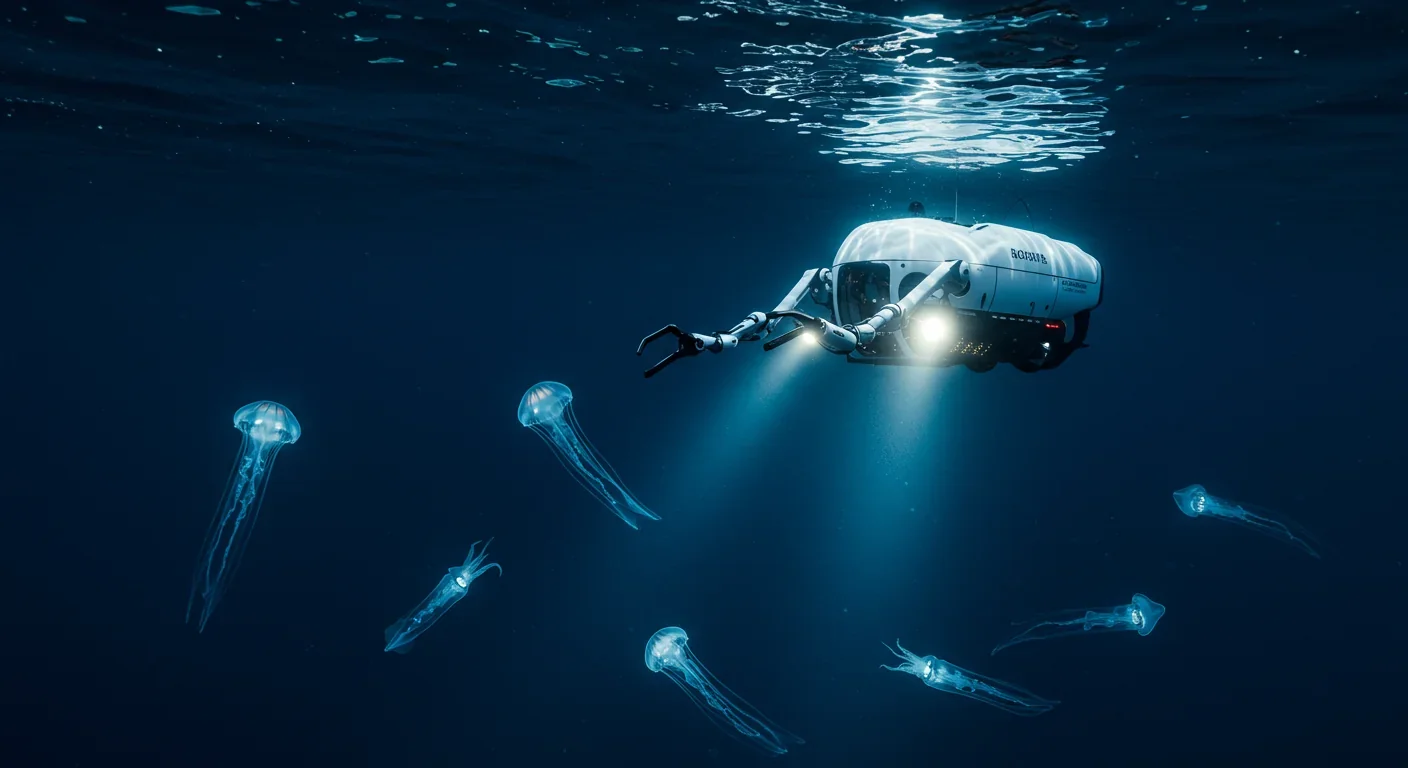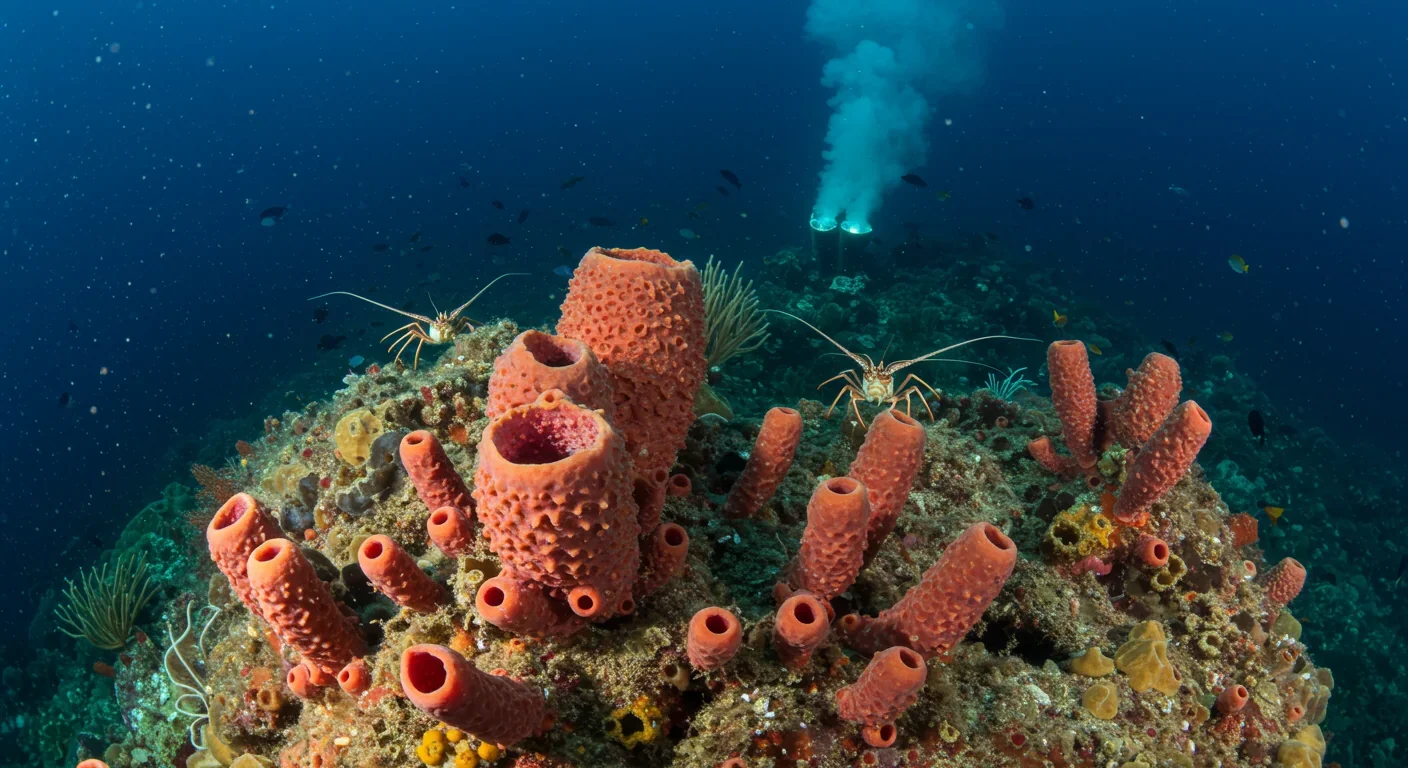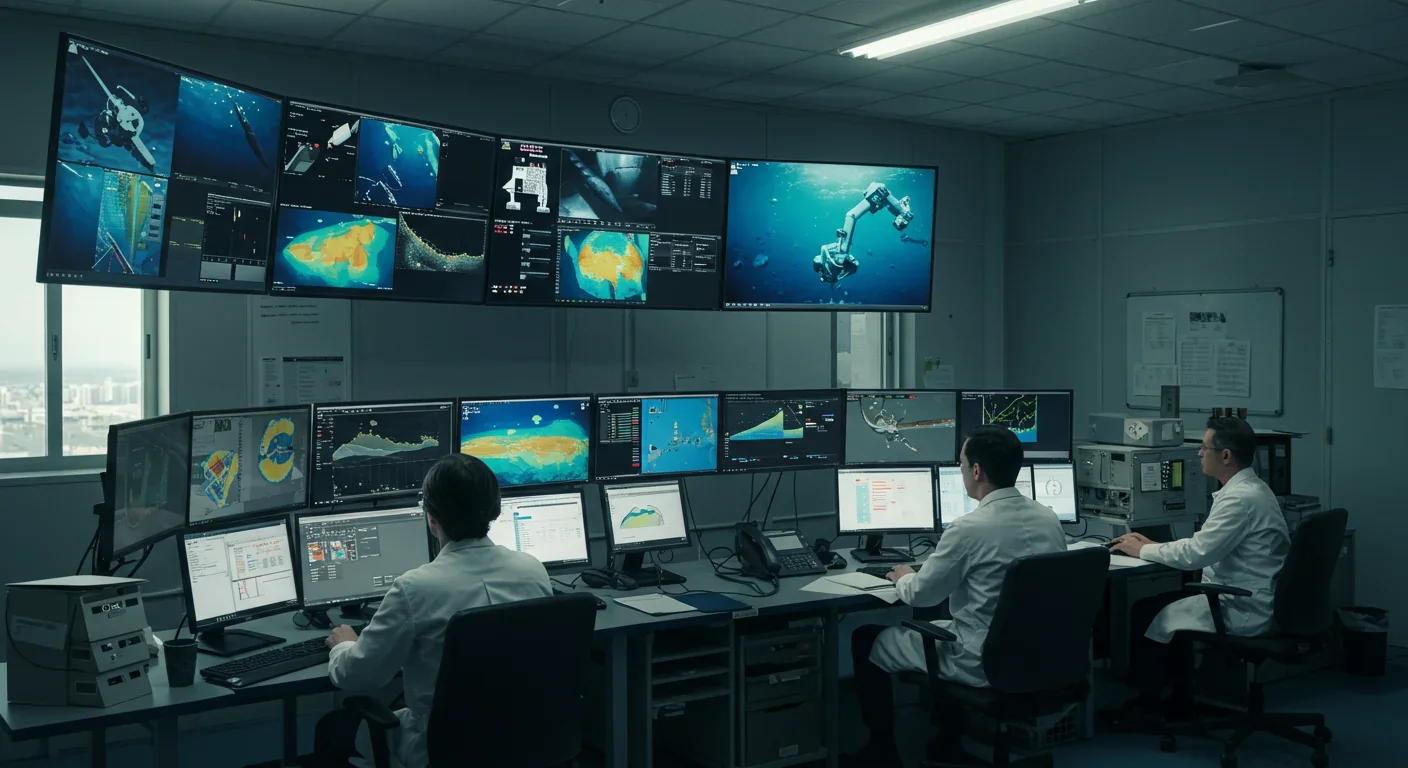Bombardier Beetle Chemical Defense: Nature's Micro Engine

TL;DR: Advanced robotics and AI are revolutionizing deep-sea exploration, revealing thousands of new species in Earth's largest unexplored ecosystem while raising urgent questions about conservation and exploitation.

By 2030, we'll know more about the seafloor than we knew about the Moon in 1969. That's not science fiction but a quiet revolution happening right now, powered by robots that can withstand pressures that would crush a submarine like a tin can. While tech billionaires race to Mars, a parallel expedition into Earth's most alien landscape is rewriting what we thought we knew about life itself. The deep sea—covering more than 60% of our planet—has remained largely untouched by human eyes, but cutting-edge technology is finally peeling back the darkness to reveal ecosystems so strange they challenge our understanding of biology.
Here's a humbling fact: we've mapped less than 25% of the ocean floor in high resolution. Compare that to Mars, where we've charted nearly 100% of the surface. The deep sea, defined as anything below 200 meters, makes up the largest living space on Earth, yet it remains more mysterious than outer space. We're talking about an environment where the pressure reaches 1,000 atmospheres, where no sunlight penetrates, and where creatures have evolved in ways that seem impossible.
Recent expeditions are changing that knowledge gap faster than ever. In 2023, scientists exploring the Mar del Plata Canyon off Argentina's coast documented over 40 potential new species in just three weeks. Translucent glass squids with horn-like appendages. Pink lobsters moving in synchronized groups. A king crab carrying more than 100 barnacles on its shell like some crustacean apartment complex. These aren't creatures from a fantasy novel but real organisms adapting to conditions we barely comprehend.
The numbers tell a story of accelerating discovery. Between 1950 and 2000, marine biologists identified roughly 1,500 new deep-sea species. In just the past decade, that number has more than doubled. Why? Because the technology finally caught up to the challenge.
You can't send humans where the pressure would instantly kill them, so we built robots that don't mind. Remotely Operated Vehicles have become the workhorses of deep-sea exploration, and they're getting smarter every year. These aren't your basic underwater drones. Modern ROVs like SuBastian—used in the Mar del Plata expedition—carry high-definition cameras, robotic arms with tactile feedback, scientific sensors that measure everything from water chemistry to temperature gradients, and specialized sampling equipment that can collect specimens without damaging them.
The real breakthrough? Real-time data transmission. When ROV SuBastian explored the Argentine canyon, over 1.6 million people watched live streams of the seafloor, seeing creatures no human had ever encountered as they were discovered. That kind of telepresence wasn't possible even ten years ago. The technology requires fiber-optic cables that can withstand enormous pressure, sophisticated lighting systems that don't disturb the animals, and AI-assisted navigation that helps pilots avoid collisions in pitch-black water.
China's Jiaolong submersible recently completed the world's first joint submersible operation in the Arctic, diving to depths of 7,000 meters. That's deeper than Mount Everest is tall. The engineering required to keep electronics functioning under 700 times atmospheric pressure involves materials science at the cutting edge—pressure housings made of titanium alloys, ceramic components that don't deform, and battery systems that maintain performance in near-freezing water.
Autonomous Underwater Vehicles take this further by operating without a tether. These independent robots can map vast areas of the ocean floor, following pre-programmed routes or adapting their path based on what they find. Some stay submerged for months, surfacing only to transmit data via satellite. The latest models use machine learning to identify interesting features—unusual rock formations, dense biological communities, hydrothermal vents—and adjust their missions accordingly.
The deep sea isn't just dark and empty. It's a museum of evolutionary experiments that never made it to shallow water. Hydrothermal vents—underwater geysers where superheated water rich in minerals erupts from the seafloor—support entire ecosystems that don't rely on sunlight. Instead, bacteria convert chemical energy from hydrogen sulfide into food, forming the base of a food web that includes giant tube worms, eyeless shrimp, and fish that can tolerate temperatures that would boil a lobster alive.
These vent communities fascinate astrobiologists because they prove life can thrive without photosynthesis. If organisms can survive on Earth's seafloor using only chemical energy, maybe Europa's subsurface ocean or Enceladus's ice-covered seas could harbor similar life. The deep sea has become our best laboratory for understanding what alien biology might look like.
Bioluminescence—the ability to produce light through chemical reactions—is almost universal in the deep sea. More than 90% of deep-sea creatures can create their own light, using it to attract prey, confuse predators, or communicate with potential mates. The patterns are so diverse that researchers have documented hundreds of distinct bioluminescent strategies. Some fish have light organs under their eyes that work like biological headlights. Others have complex patterns on their bodies that create signals only their species can recognize.
Cold seeps, where methane and other hydrocarbons leak from the seafloor, create another type of chemosynthetic ecosystem. Microbes that eat methane form thick mats on the seafloor, and these attract communities of clams, mussels, and tube worms that can grow to enormous sizes. A recent study of cold seeps discovered hundreds of fungal species, challenging our assumptions about what can survive in such extreme conditions.

Deep-sea biodiversity rivals tropical rainforests, but we're only scratching the surface of understanding it. Every major expedition discovers species that rewrite taxonomic categories. The Mar del Plata expedition alone found potential new species of anemones, sea cucumbers, sea urchins, snails, and crinoids—ancient relatives of starfish that were more diverse during the age of dinosaurs.
Some discoveries challenge basic biological assumptions. Researchers have found fish living at depths once thought impossible for vertebrates, their bodies adapted with special proteins that prevent cellular collapse under extreme pressure. Others have discovered microbes that metabolize sulfur, iron, or even arsenic, expanding the known range of biochemistries life can use.
The abyssal plains—vast flat areas of the deep ocean floor—were long assumed to be biological deserts. High-resolution mapping has revealed they're anything but. Seamounts, underwater mountains that don't break the surface, create hotspots of diversity where currents concentrate nutrients. Some seamounts support thousands of species, many found nowhere else.
The cost of deep-sea exploration has dropped dramatically thanks to improvements in several key technologies. Fiber-optic cables that can withstand crushing pressure enable real-time control of ROVs from ships or even from shore-based control centers. Scientists in California can pilot robots exploring vents near Iceland, collaborating with colleagues across time zones without needing expensive ship time.
Sonar mapping has become so precise we can now detect objects the size of a car on the ocean floor from ships on the surface. Multibeam echosounders emit hundreds of sound pulses simultaneously, building 3D maps of underwater terrain with resolution measured in centimeters. This technology, originally developed for submarine warfare, now helps researchers identify promising sites for biological surveys.
Advanced imaging systems capture high-resolution video in conditions where human eyes would see nothing. LED lighting systems provide powerful illumination without generating heat that would disturb deep-sea organisms. Hyperspectral cameras can distinguish between different types of rock or biological material, helping scientists identify areas likely to host unique communities.
Sample collection has evolved beyond simple grabbing. Modern ROVs use suction samplers that gently capture small organisms without crushing them, pressurized containers that maintain deep-sea conditions as specimens are brought to the surface, and DNA sequencers that can identify species from environmental samples without needing to capture animals at all.
Abu Dhabi's marine conservation program demonstrates how AI and sensor networks are creating new approaches to ocean monitoring. Networks of underwater sensors track changes in temperature, salinity, and oxygen levels, transmitting data via acoustic modems. Machine learning algorithms analyze this data to identify patterns that might indicate ecosystem stress or unusual events worth investigating.
Every new technology brings unintended consequences. The Mar del Plata expedition found lost fishing gear, plastic bags, and other debris in what should be one of Earth's most remote ecosystems. Sediment cores collected by the ROV captured microplastics trapped in the seafloor, creating a baseline for tracking how human pollution reaches even the deepest parts of the ocean.
Deep-sea mining poses perhaps the most serious threat. Rare earth elements and valuable minerals accumulate in nodules on the abyssal plains, and several countries have explored extracting them. The problem? We don't understand these ecosystems well enough to predict the impacts. Mining operations could destroy habitats for species we haven't discovered yet, species that might hold secrets about evolution, adaptation, or biochemistry.
Mapping the ocean floor creates its own dilemmas. Detailed maps help conservationists identify areas worth protecting, but they also help commercial interests locate resources to exploit. Fishing companies use advanced sonar to find seamounts where fish congregate, often devastating these ecosystems faster than scientists can study them.
Climate change is reaching the deep sea too. Temperature changes affect the currents that distribute nutrients and oxygen. Acidification—caused by the ocean absorbing carbon dioxide from the atmosphere—is making it harder for organisms with calcium carbonate shells to survive. Some deep-sea corals, which can live for thousands of years, are showing stress from conditions they've never encountered in their entire existence.
Protecting ecosystems we barely understand requires a different approach than traditional conservation. You can't put a fence around a hydrothermal vent or patrol the abyssal plains for poachers. Instead, marine protected areas in the deep sea rely on international agreements and remote monitoring.
The challenge is scale. Creating an effective network of marine protected areas means protecting representative examples of every major habitat type—seamounts, vents, seeps, trenches, canyons, and plains. That requires mapping we don't have yet and understanding of species ranges that's still incomplete.
Some progress is happening. The International Seabed Authority, which regulates activities in international waters, has established several areas where mining is prohibited. Regional fisheries management organizations have closed some seamounts to bottom trawling. But enforcement remains difficult, and economic pressures to exploit deep-sea resources are intensifying.
Technology offers some solutions. Satellite monitoring can detect ships in restricted areas. DNA analysis of seafood can identify illegal catches of deep-sea species. But the fundamental challenge remains: how do you protect something most people will never see and don't think about?

The pace of discovery is accelerating. The Ocean Census initiative aims to identify 100,000 new marine species in the next decade, many from the deep sea. Advances in genetic sequencing mean researchers can characterize entire ecosystems from water samples, identifying species without ever seeing them.
Artificial intelligence is starting to play a larger role. Machine learning algorithms can analyze hours of video footage, identifying and counting organisms faster than human researchers. Neural networks trained on existing data can predict where undiscovered hydrothermal vents are likely to exist, helping scientists target their searches.
Citizen science is expanding too. Those 1.6 million people watching the Mar del Plata expedition weren't just passive observers. Many submitted observations that helped researchers identify interesting features or behaviors. Platforms that let the public analyze deep-sea footage and tag organisms are turning ocean exploration into a collaborative effort.
Future ROVs might incorporate soft robotics—manipulators that can handle delicate specimens without crushing them—and advanced AI that can make decisions about what to investigate without constant human guidance. Some researchers envision swarms of small autonomous vehicles working together, covering more area than single large ROVs while costing less.
Despite all the technology, human expertise remains irreplaceable. ROV pilots develop an intuition for navigating complex underwater terrain that no AI can match yet. Marine biologists can spot unusual organisms that algorithms might miss. The combination of human judgment and machine capability is what makes modern deep-sea exploration so effective.
Dr. Daniel Lauretta, who led the Mar del Plata expedition, emphasized that public engagement is critical for raising awareness about ocean conservation. When people can watch discoveries happen in real time, they develop a connection to ecosystems they'll never visit personally. That emotional connection translates into support for conservation policies and funding for research.
The deep sea is training the next generation of ocean scientists. Students who watch live feeds from research vessels get inspired to pursue marine biology. Programs that bring research expeditions into classrooms are creating a pipeline of future scientists who understand that Earth's greatest frontier isn't in space but in our own oceans.
We stand at a pivotal moment. Technology has finally given us the tools to explore Earth's largest ecosystem, but we're racing against our own capacity to damage it. The decisions made in the next decade about how we use and protect the deep sea will determine whether future generations inherit an ocean full of undiscovered wonders or a depleted wasteland.
The deep sea isn't just a curiosity for scientists. It regulates our climate by absorbing carbon dioxide and heat. It provides ecosystem services we're only beginning to quantify. Organisms living in extreme conditions might hold solutions to problems from disease to materials science. We're exploring it not just to satisfy curiosity but because understanding it is essential for our own survival.
Every expedition reveals how much we don't know. Pink lobsters and translucent squids are charming, but they're also reminders that our planet can still surprise us. The deep sea is Earth's largest reservoir of biodiversity, climate regulation, and scientific potential. The question is whether we'll have the wisdom to protect it while we're still figuring out what it contains.
The technology exists. The need is clear. What happens next depends on whether we can balance exploration with conservation, curiosity with caution, and the drive to discover with the responsibility to preserve. The deep sea is finally revealing its secrets, and what we do with that knowledge will define our relationship with the ocean for generations to come.

Recent breakthroughs in fusion technology—including 351,000-gauss magnetic fields, AI-driven plasma diagnostics, and net energy gain at the National Ignition Facility—are transforming fusion propulsion from science fiction to engineering frontier. Scientists now have a realistic pathway to accelerate spacecraft to 10% of light speed, enabling a 43-year journey to Alpha Centauri. While challenges remain in miniaturization, neutron management, and sustained operation, the physics barriers have ...

Epigenetic clocks measure DNA methylation patterns to calculate biological age, which predicts disease risk up to 30 years before symptoms appear. Landmark studies show that accelerated epigenetic aging forecasts cardiovascular disease, diabetes, and neurodegeneration with remarkable accuracy. Lifestyle interventions—Mediterranean diet, structured exercise, quality sleep, stress management—can measurably reverse biological aging, reducing epigenetic age by 1-2 years within months. Commercial ...

Data centers consumed 415 terawatt-hours of electricity in 2024 and will nearly double that by 2030, driven by AI's insatiable energy appetite. Despite tech giants' renewable pledges, actual emissions are up to 662% higher than reported due to accounting loopholes. A digital pollution tax—similar to Europe's carbon border tariff—could finally force the industry to invest in efficiency technologies like liquid cooling, waste heat recovery, and time-matched renewable power, transforming volunta...

Humans are hardwired to see invisible agents—gods, ghosts, conspiracies—thanks to the Hyperactive Agency Detection Device (HADD), an evolutionary survival mechanism that favored false alarms over fatal misses. This cognitive bias, rooted in brain regions like the temporoparietal junction and medial prefrontal cortex, generates religious beliefs, animistic worldviews, and conspiracy theories across all cultures. Understanding HADD doesn't eliminate belief, but it helps us recognize when our pa...

The bombardier beetle has perfected a chemical defense system that human engineers are still trying to replicate: a two-chamber micro-combustion engine that mixes hydroquinone and hydrogen peroxide to create explosive 100°C sprays at up to 500 pulses per second, aimed with 270-degree precision. This tiny insect's biochemical marvel is inspiring revolutionary technologies in aerospace propulsion, pharmaceutical delivery, and fire suppression. By 2030, beetle-inspired systems could position sat...

The U.S. faces a catastrophic care worker shortage driven by poverty-level wages, overwhelming burnout, and systemic undervaluation. With 99% of nursing homes hiring and 9.7 million openings projected by 2034, the crisis threatens patient safety, family stability, and economic productivity. Evidence-based solutions—wage reforms, streamlined training, technology integration, and policy enforcement—exist and work, but require sustained political will and cultural recognition that caregiving is ...

Every major AI model was trained on copyrighted text scraped without permission, triggering billion-dollar lawsuits and forcing a reckoning between innovation and creator rights. The future depends on finding balance between transformative AI development and fair compensation for the people whose work fuels it.